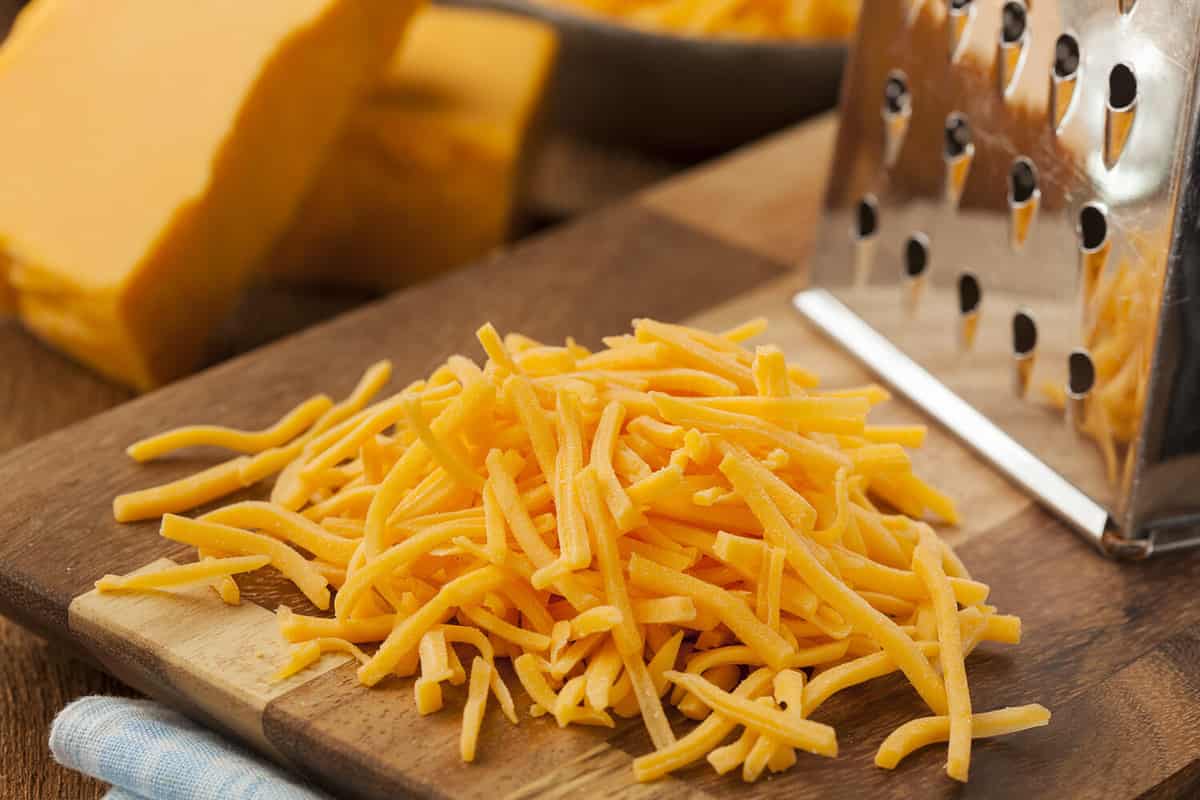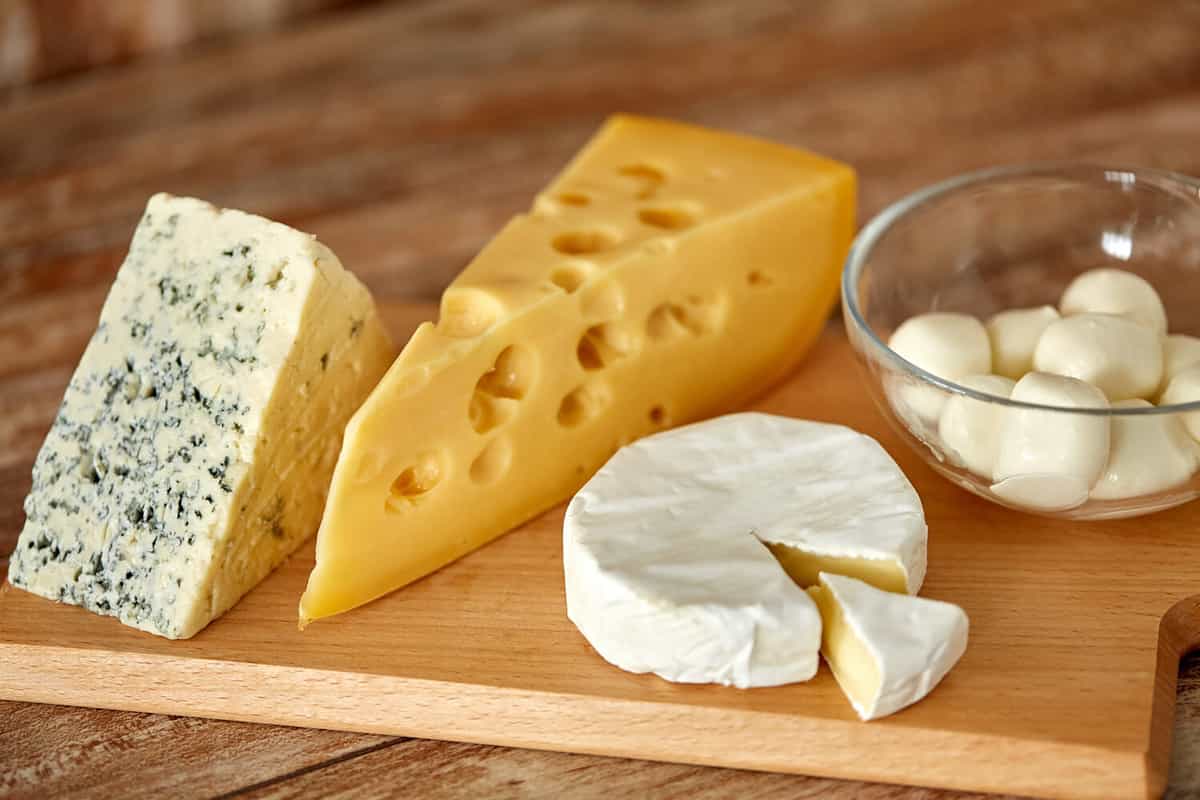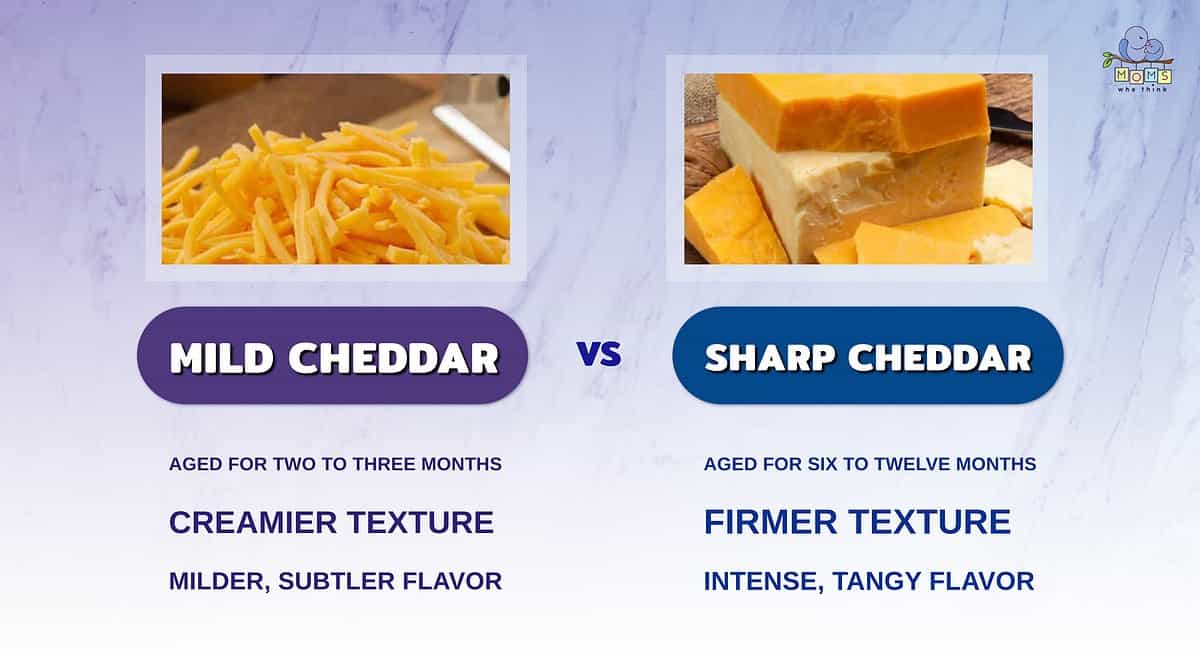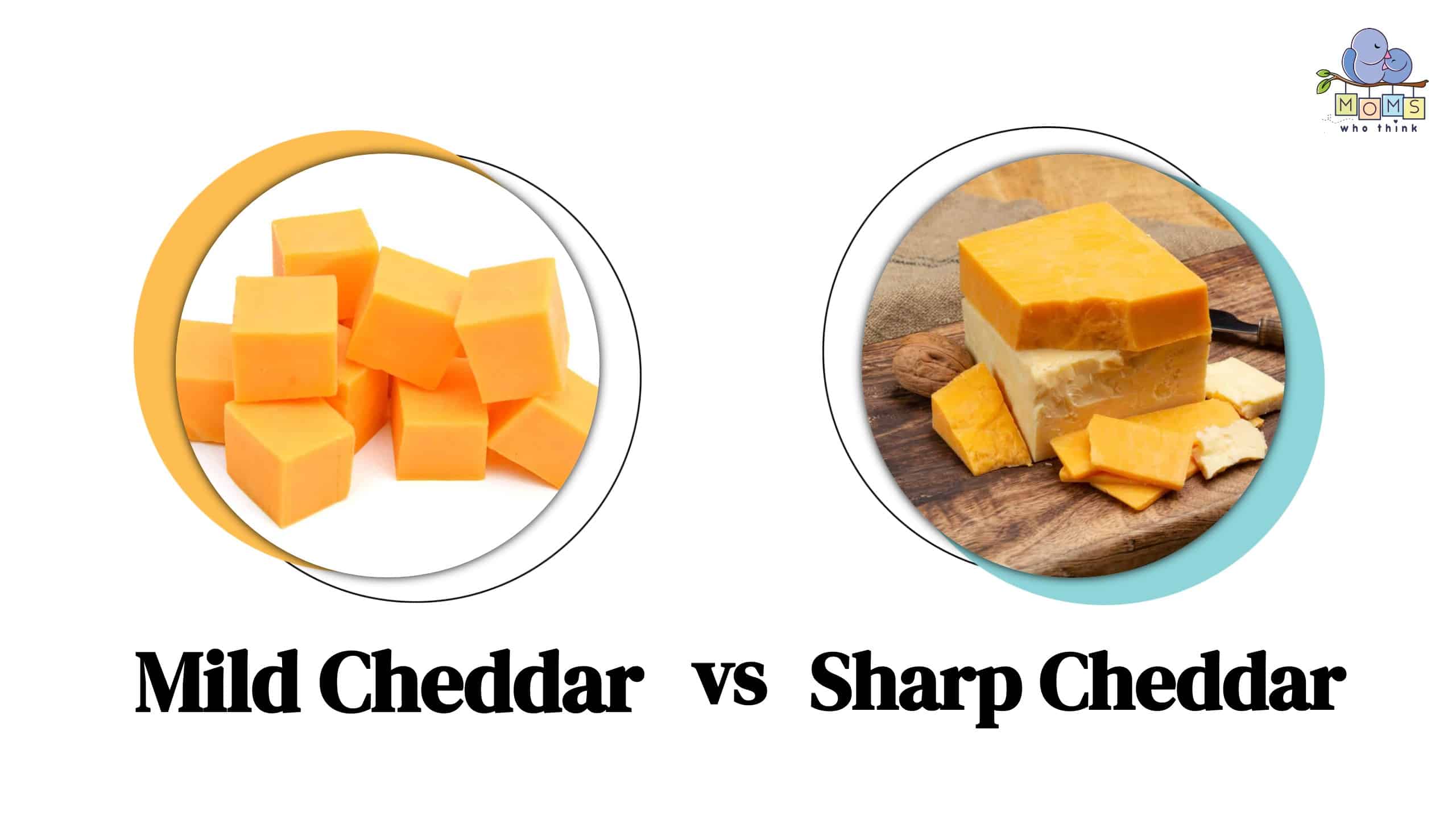Did you know that cheddar is the most popular cheese in America according to a recent survey? Whether you're packing a school lunch, cooking your family's next dinner, or arranging a charcuterie board, cheddar is likely to be a staple ingredient. But why are there mild and sharp varieties? What's the difference and which one is best for your next meal?
In this post, we're going to take an in-depth look at the difference between mild and sharp cheddar. While these two versions of America's favorite cheese may look the same, they differ in taste and texture. Let's closely examine what sets them apart so you know which option is best for your next recipe.
Mild Cheddar vs. Sharp Cheddar: What is the Difference?

©Brent Hofacker/Shutterstock.com
The primary difference between mild and sharp cheddar cheese is their aging process. Mild cheddar is left to age for only 2 to 3 months while sharp cheddar can age anywhere from 6 to 12 months. This difference in their aging process leads to different tastes and textures in both cheeses.
Mild cheddar is creamier with a milder, more subtle flavor whereas sharp cheddar's texture is firmer with a more pronounced, tang flavor. The more mellow flavor of mild cheddar makes it ideal for sandwiches while sharp cheddar's more robust flavor makes it ideal for crackers or cheese boards.
Let's take a closer look at how mild and sharp cheddar differ.
Flavor
The flavor of mild and sharp cheddar is the largest difference between these two varieties. Due to mild cheddar's shorter aging time, its flavor tends to be mild and buttery. Sharp cheddar, on the other hand, has a longer aging time which gives the cheese a sharper and more complex flavor. The distinct flavoring of sharp cheddar can also include hints of nuttiness, tanginess, and sometimes even a slight sweetness.
Texture
Mild cheddar has a smooth and creamy texture with a slight firmness that allows it to hold its shape when sliced. Because it's only aged for a couple of months, mild cheddar also has a higher moisture content. This makes it a great cheese for melting.
As mentioned, sharp cheddar has a longer aging time. This time frame gives the cheese a crumbly texture that can vary depending on how long it has been aged. The longer the aging process, the drier and more crumbly the cheese becomes.
Are Mild Cheddar and Sharp Cheddar the Same Thing?
While mild and sharp cheddar are not the exact same, they do share some commonalities. Their flavor and texture may differ, but their origin, appearance, production process, and use in the kitchen are nearly identical.
Origin
Cheddar cheese originates from the town of Cheddar in Somerset, England dating back as far as the 12th century. It's thought that the original production of cheddar was white, with the yellow coloring being a later addition to the production process.
As the production process was enhanced over time, techniques were developed for controlling the temperature and acidity of the milk to produce consistent and high-quality cheese. Soon after, cheddar cheese was exported to other countries.
Cheddar cheese is now one of the most popular cheeses across the world. Large cheese factories have been created to meet the growing demand and numerous varieties of this sharp, tangy cheese.
Appearance
When it comes to the look of cheddar cheese, whether mild or sharp, there are two different varieties: White and yellow. White cheddar is the coloring of the cheese in its natural state. Yellow cheddar is the by-product of the addition of annatto to the cheese. This is sometimes done to control the coloring of the cheese and give it a more uniform yellow-orange pigment.
How Cheddar Cheese Is Made
Cheddar cheese, whether mild or sharp, begins its production process like most cheeses: By adding rennet to milk in order to create curdles. The curds are then cut into pieces, pressed, and continually flipped to remove as much liquid (or whey) as possible. What's left is dense, dry, and somewhat crumbly cheddar cheese. This process of stacking and turning the curds repeatedly is unique enough that it's been coined, “cheddaring.”
The final point of production is the aging process, which, as we know, can differ depending on whether mild or sharp cheddar is being manufactured.
Popular Uses
Both mild and sharp cheddar are extremely versatile and can be used in nearly any capacity. It's worth noting, however, that mild tends to melt a little better than sharp cheddar due to its added moisture and shorter aging process.
Mild cheddar is often used in dishes like grilled cheese sandwiches, mac and cheese, and casseroles. Sharp cheddar, on the other hand, is drier which makes it ideal for grating and adds a nice texture to dishes like salads and baked potatoes.
It's also important to note that the pre-shredded forms of cheddar cheese typically found in your local grocery store include cornstarch to prevent clumping. If you're looking for a stronger flavor and a more creamy melted version, try shredding a block of cheddar yourself. Both white and yellow cheddar are easy to shred and offer a creamier texture when shredded fresh.
Can You Substitute Mild Cheddar with Sharp Cheddar?

©Ground Picture/Shutterstock.com
While mild and sharp cheddar have different flavors and textures that range from mild and smooth to sharp and crumbly, they can still often be substituted for each other at a 1:1 ratio.
Keep in mind, however, that swapping these cheeses for each other can alter the flavor of your dish. If a recipe calls for mild cheddar, you may not want to include the strong, tangy flavor of sharp cheddar. Additionally, sharp cheddar is best in recipes that require a bolder flavor. The mellowness of mild cheddar may not stand up to the other flavors in a dish.
Best Substitutes for Mild Cheddar
If you're on the hunt for a cheese that closely resembles the buttery smoothness of mild cheddar, here are a few options to try:
Colby Cheese
While this cheese tends to be even milder and softer than mild cheddar, it still makes for a great replacement in a pinch. Just keep in mind that Colby has an even higher moisture level than mild cheddar, which may affect your dish.
Monterey Jack Cheese
Monterey Jack is similar to Colby in that it's slightly softer in texture due to a higher moisture level, and tends to be a little milder than mild cheddar. Even so, this cheese makes for a great substitute on grilled cheese sandwiches, quesadillas, and mac and cheese.
Gouda Cheese
Gouda is also a semi-soft cheese with a mild flavor. It also tends to have a slightly different flavor profile which can make for a delicious twist to grilled burgers and mac and cheese. Just be sure to note the age of the Gouda you're using. Aged Gouda tends to be a closer resemblance to sharp cheddar.
Best Substitutes for Sharp Cheddar
Looking for something similar to the tangy crumbliness of sharp cheddar? Here are a few options to try:
Extra Sharp Cheddar Cheese
Yep, this is a variety of cheddar, too! Knowing what we know about the aging process that differentiates mild cheddar from sharp cheddar, you can probably guess that extra sharp cheddar has aged for even longer. Extra sharp cheddar works well in dishes that require a bolder, more complex flavoring.
Gruyere Cheese
Gruyere cheese is a hard cheese that has a nutty, slightly sweet flavor and a firm texture that melts well. Similar to Gouda, it offers a different flavor profile that can add a twist to dishes like cheese fondue and quiches.
Parmesan Cheese
Parmesan is a hard, salty cheese that can be grated and used as a topping or garnish for salads, pasta dishes, and more. It can add a strong, salty flavor as a substitute for sharp cheddar. Keep in mind, however, that parmesan doesn't melt well, so it won't make a great replacement in dishes that require a creamy, melty cheese.
Best Recipes for Mild and Sharp Cheddar
Whether you're using mild or sharp cheddar, either version of cheese will work great in the following recipes:
Print
Cheddar Barbecue Chicken
Ingredients
4 boneless skinless chicken breasts
8 strips bacon, cooked
shredded cheddar cheese
1 bottle barbecue sauce
Instructions
1. Cover Chicken breasts with barbecue sauce and bake until done, about 15-30 minutes in a 350 degree oven.
2. Remove from oven, pour additional barbecue sauce on top, place bacon strips on top of the chicken breasts and cover with cheddar cheese.
3. Return to oven until cheese melts. Serves 4.
- Cheddar Chicken Casserole in the Crockpot
- Cheddar Baked Cauliflower
- Pulled Smokey Chicken Sandwiches with Cheddar
Final Thoughts

- Mild cheddar is only aged for two to three months, while sharp cheddar is aged for six to twelve months. This difference in aging is what creates the difference in taste and texture.
- Sharp cheddar has a firmer texture than mild cheddar.
- The intense, tangy flavor of sharp cheddar may be your favorite, or it might be too much for you. If you fall into the latter category, you'll love the milder, subtler flavor of mild cheddar.
In conclusion, cheddar cheese is a popular ingredient that's used in many households across America. Although mild and sharp cheddar may look similar, they each have distinct differences in flavor and texture.
Whether you're looking for the creamy smoothness of mild cheddar or the tangy boldness of sharp cheddar, either variety can make a splash in the kitchen. Understanding the difference between these two types of cheddar can help you choose the right cheese for your next recipe and elevate the taste of your dish.


